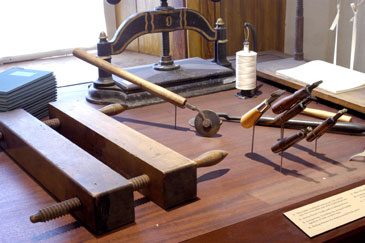Bindery
Many of the books included in Lasting Impressions were bound by hand with tools that have changed little for centuries. When machines replaced craftspeople during the 19th century’s industrial revolution, inexpensive bindings were rapidly turned out to meet the demand of a growing publishing trade. Still, the binding of books by hand has survived as an art form closely associated with private press editions. Tools from the Press of the Palace of the Governors, Santa Fe, New Mexico.
 Photo ©2005 Blair Clark.
Photo ©2005 Blair Clark.
- Bone Folder. Traditional creasing tool with multiple uses. One of the oldest tools of the bookbinding trade.
- Sewing Thread. Usually made of unbleached linen.
- Sewing Frame. To facilitate the sewing of multiple signatures of books on fabric tapes.
- Backing Hammer. For shaping rounded book spines.
- Fillets. Tool used to make continuous lines on leather covers.
- Finishing Tools. Carefully heated and applied to covers to create decoration. Sometimes used with gold foil.
- Finishing Press. For holding a book in place while work is being performed on the spine.
- Nipping Press. Used for light and quick book pressing. Usually the last step in binding a book.

